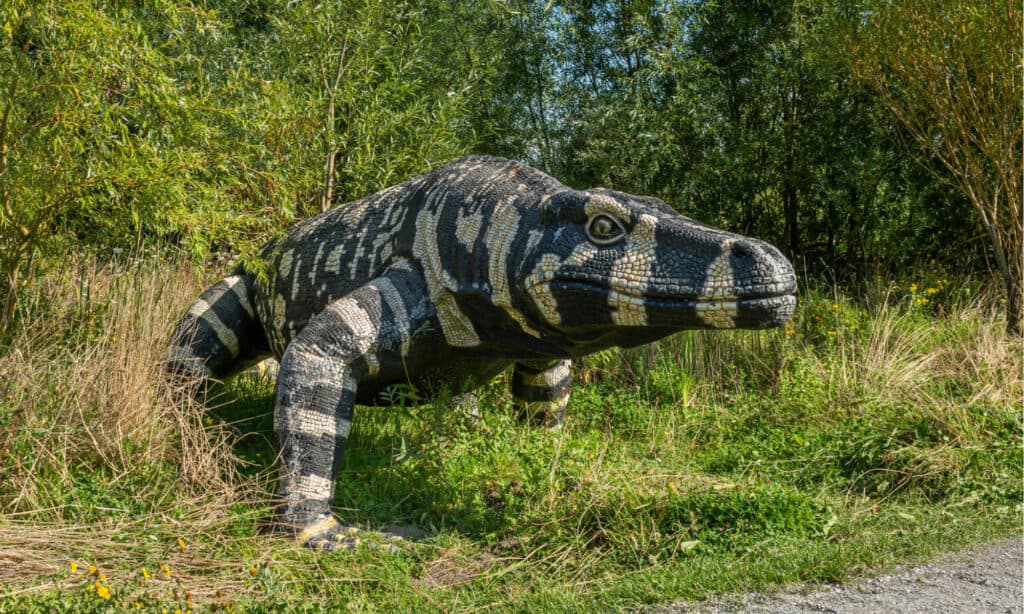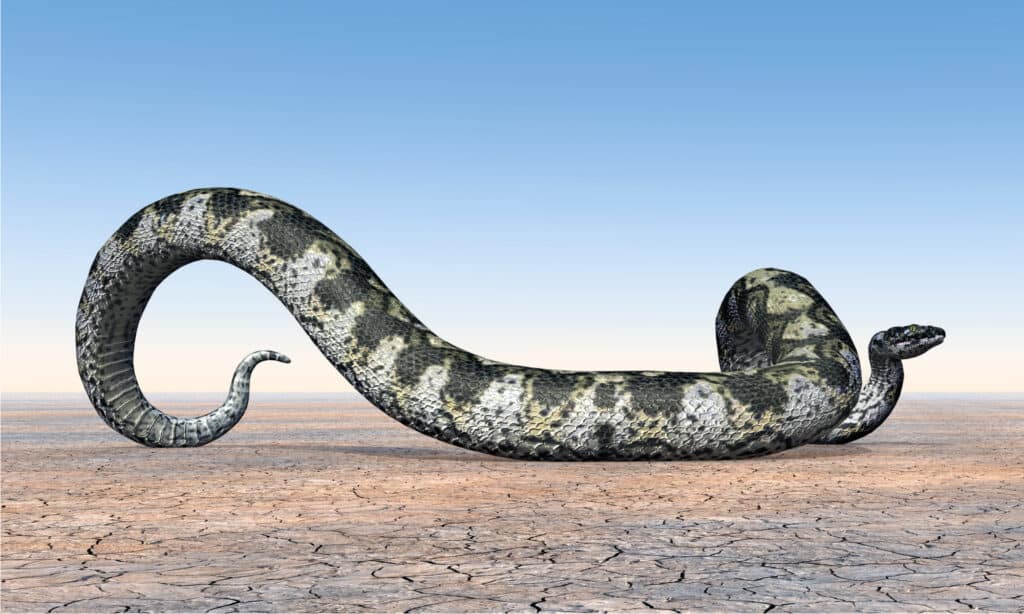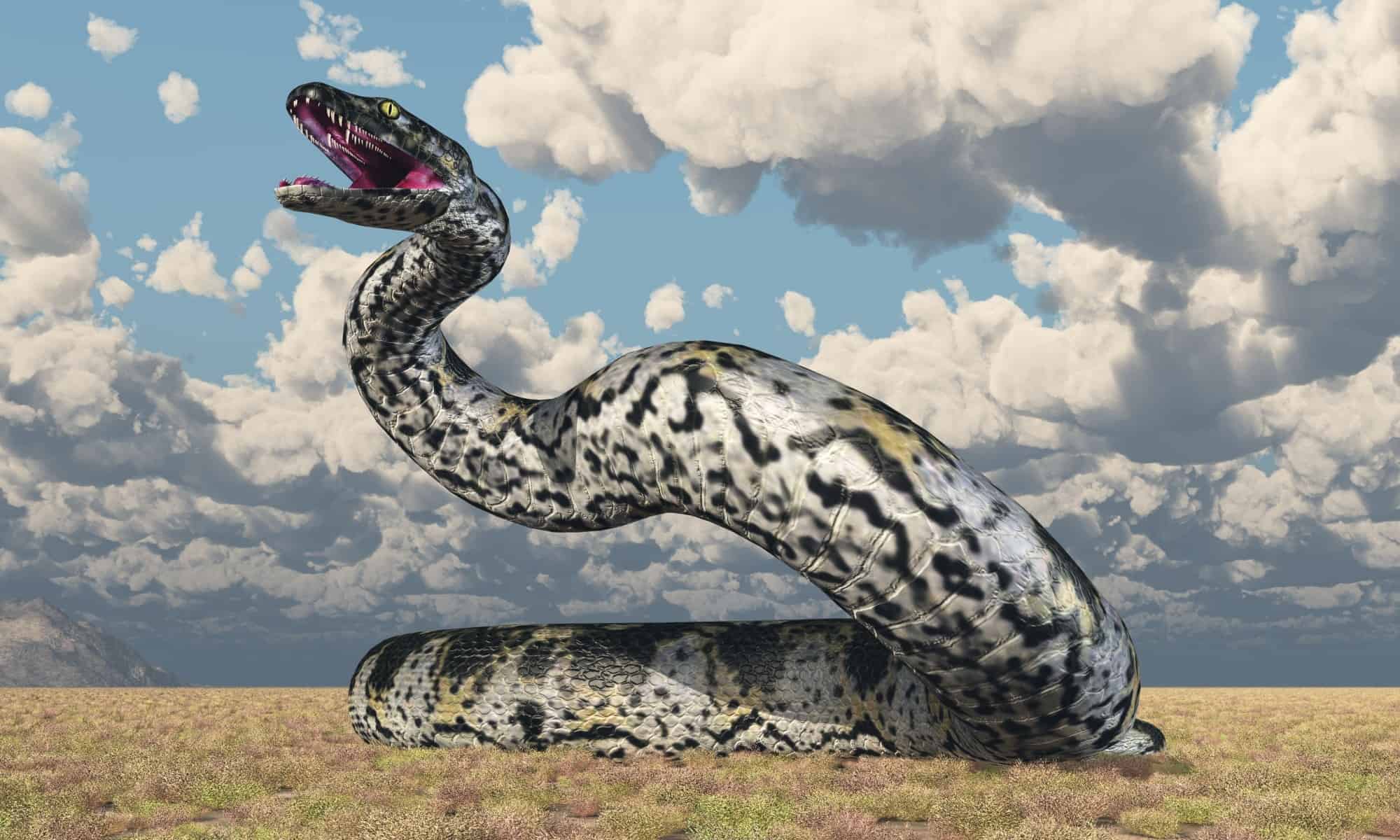The history of the world is riddled with cases of megafauna that dwarf anything that lives today. Two interesting cases of extremely big reptiles are the Titanoboa and the Megalania, the largest snake and the largest lizard ever recorded, respectively. Given their vast differences, it’s only natural to wonder which one of them would survive a battle against the other. Today, we’re going to imagine a battle between the largest snake ever vs a two-ton lizard!
We’ll use data from these two reptiles to figure out which one would finish off the other!
Comparing The Largest Snake Ever and a Two-Ton Lizard
| Largest Snake Ever | Two-Ton Lizard | |
|---|---|---|
| Size | Weight: 1,600 to 2,500 pounds Length: 40 to 50 feet | Weight: from 200 to 4,200 pounds Length: 18 to 23 feet at maximum Height: perhaps 3 feet tall |
| Speed | – Would have been very slow on land – Swim speed under 10 mph (estimated based on anaconda) | – 5.8 to 6.7 mph |
| Defenses | – Incredibly thick, round body would be hard to bite – Most likely spent a fair amount of time in the water, making it hard to find – The snake’s color would make it hard to see when it was hiding in vegetation | – Large, thick body would offer some protection against attacks – Could probably outpace some animals |
| Offensive Capabilities | – Thin, sharp teeth meant to bite and hold creatures – A constrictor snake, this reptile would have wrapped its massive body around other creatures – Would constrict prey to death, overwhelming their circulatory system or stopping respiration | – Might have had a hemotoxic venom similar to modern Komodo dragons – Their bites would deliver an anticoagulant that would increase bleeding in their foes – Highly serrated, sharp teeth measuring under an inch long |
| Predatory Behavior | – Most likely an ambush predator | – May have been an opportunistic predator or an ambush predator – May have acted as a scavenger |
What Are 3 Key Differences Between the Largest Snake Ever and a Two-Ton Lizard?
The most significant differences between the largest snake ever and a two-ton lizard are found in their morphology, size, and attack methods. The largest snake ever was a very thick, rounded, limbless creature that weighed about 1,600 to 2,500 pounds and used constriction to kill prey that it did not eat whole. Meanwhile, the two-ton lizard was a quadrupedal reptile with a long tail that measured from 18 to 23 feet long, weighed up to 4,200 pounds, and stood about 3 feet tall. This creature would bite its prey to death, using a form of hemotoxic venom to help exsanguinate and weaken its prey.
These differences will have a major impact on the fight. Yet, we need more data to conclude which animal would have a better chance of winning the fight.

Megalania, which means “giant roamer” in Greek, was a very large Australian lizard that existed at the end of the Pleistocene Epoch.
©Erik Laan/Shutterstock.com
What Are the Key Factors in a Fight Between the Largest Snake Ever and a Two-Ton Lizard?
The most important factors in most fights between animals can be found in their size and attack methods. Of course, other factors matter too. We’re going to look at five different factors, see which animal has an advantage in that particular element, and use the combined data to determine which creature has the most going for it in this battle.
Following this section, we’ll decide which animal has a higher chance of surviving the fight.
The Largest Snake Ever vs Two-Ton Lizard: Size
The two-ton lizard was possibly heavier than the largest snake ever, but it lacked the length of the Titanoboa. Scientists continue to debate the actual size of this creature. Some have said it weighed as much as 4,200 pounds while others say it weighed 200 pounds. Still, others claim that it weighed about 700 pounds or so and measured from 18 to 23 feet while standing 3 feet tall.
Titanoboa is a little less mysterious, and it probably weighed between 1,600 pounds and 2,500 pounds while measuring between 40 and 50 feet long.
The lizard has the weight advantage, but the snake has the size advantage.
The Largest Snake Ever vs Two-Ton Lizard: Speed
The two-ton lizard probably had a maximum speed of between 5.8 and 6.7 mph. However, we don’t know how quickly the largest snake moved. Modern anacondas can briefly reach speeds of 10 mph in the water. However, it’s doubtful something as large as Titanoboa could have kept that pace.
On land, the fastest anaconda can move at speeds of about 5 mph. Again, the largest snake ever was far more robust, so it’s not very likely that it could reach or maintain such a speed for a long time.
The two-ton lizard has the speed advantage.
The Largest Snake Ever vs Two-Ton Lizard: Defenses
Both the largest snake ever and the two-ton lizard would rely on their physical size to keep them safe. However, each animal has some facets that offer more protection. For one thing, the two-ton lizard may have had a similar physiology to modern monitor lizards.
For instance, Komodo dragons have tough skin reinforced with osteoderms that resist penetration. However, when if their body’s protection failed, the lizard could probably have fled from anything large enough to kill it. Those osteoderms could be the difference between Titanoboa latching onto it or failing.
The largest snake ever lacked speed, but it spent most of its time in the water where it could move and maneuver fastest. Furthermore, the snake was hidden in the water, and its coloration probably helped it stay hidden until it was time to strike.
Another consideration is the overall shape of the snake’s body. Its large, round body would be hard for most creatures to bite unless they could open their jaws effectively.
In this case, the largest snake ever has the defensive advantage.

likely weighed between 1,600 and 2,500 pounds while measuring 40 to 50 feet long.
©Michael Rosskothen/Shutterstock.com
The Largest Snake Ever vs Two-Ton Lizard: Offensive Capabilities
Scientists believe that the two-ton lizard was most likely similar to the Komodo dragon in terms of its attacks. These creatures had serrated, sharp teeth measuring a little less than an inch long. The Megalania would deliver bite after bite to its enemy, tearing them open.
While it was biting, the lizard would introduce an anticoagulant venom into the prey. This hemotoxin would make the prey bleed quicker, weakening it so that it could not fight back.
The largest snake ever was not a venomous snake, though. Instead, this creature constricted its prey after biting and latching onto them. It would wrap its massive body around prey, when needed, and cause its circulatory system to fail while preventing respiration. Then, the snake would swallow the animal whole.
Both creatures have deadly attacks, but the largest snake ever has the advantage because its attack is more effective in this fight.
The Largest Snake Ever vs Two-Ton Lizard: Predatory Behavior
Based on what is known about it, the two-ton lizard could have been an ambush predator, opportunist, or scavenger. Meanwhile, the largest snake ever probably ambushed its prey in the water or near the water. The snake could have snagged fish or other creatures while swimming too.
While they’re both ambush predators, the snake’s attack from the water’s edge or while camouflaged in the vegetation is far more effective than the lizard waiting for prey in a burrow or in the vegetation.
Who Would Win in a Fight Between the Largest Snake Ever and a Two-Ton Lizard?
The largest snake ever would win a battle against a two-ton lizard. For starters, we don’t even know if the lizard was two tons. Scientists seem to think a 4,000-pound lizard is not very realistic. Another problematic element of this fight is the Titanoboa‘s size. This snake could have been three feet in diameter, making it very difficult for the lizard to bite.
Even if the lizard did bite the snake, its teeth measured less than an inch long. That’s not going to do enough damage to kill the snake without some serious work. Also, its venom was not going to kill the snake outright or in time to save the lizard.
The most likely outcome would be the Titanoboa engaging the lizard by ambushing it from water or another hidden spot. The snake may not land its first bite, but it will find an anchor point and begin wrapping the creature up, eventually squeezing the life out of it.
Any bites that the Titanoboa sustains in this fight would not be enough to kill it. In short, even the largest version of this “two-ton lizard” is not enough to stop the might of the world’s largest snake of all time.
Bonus: Why Did Reptiles Grow to Be so Large 250 Million Years Ago?

Titanoboa is believed to be the largest snake that ever lived.
©Daniel Eskridge/Shutterstock.com
Not too long ago, it was believed that giant reptiles like the Titanoboa grew to such monstrous proportions due to a lack of competition after two of the biggest mass extinction events in the history of the planet. These mass extinctions occurred around 261 and 252 million years ago and seemed to result in a period of the domination of reptiles over all other species. A new study considers another theory – could reptiles, cold-blooded creatures that they are – have grown so large because temperatures had risen to new highs? According to Harvard paleontologists, the answer is yes.
New research shows that reptiles had begun adapting to hotter temperatures before the mass extinction events had happened – and their gargantuan growth continued to accelerate as the planet grew warmer. It seems that climate change directly triggered the growth response of reptiles millions of years ago. Major shifts in global temperature had a dramatic impact on biodiversity and led to the extinction of many animals during the Permian-Triassic period but also to the evolution of others – especially reptiles. Could global warming cause modern-day reptiles to grow larger? Unfortunately, the answer is yes, some reptiles will undoubtedly grow much larger and will consume larger prey.
Thank you for reading! Have some feedback for us? Contact the AZ Animals editorial team.








